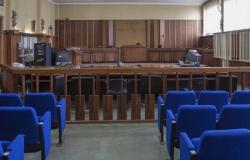Perhaps not everyone knows that even the great artist Fausto Melotti (Rovereto, 1901 – Milan, 1986), sculptor, painter, composer, designer and poet, had a “Turin” period: in 1925 the young Fausto arrived in the Piedmontese capital as a guest of his maternal uncle Carlo Faitassistant to the famous sculptor Pietro Canonica: here, as a student of the Albertina Academy, he had his first dazzling encounter with sculptural practice.
And in Turin today one of his large sculptures, Ascending Modulation, created in 1977, welcomes visitors in the garden in front of the Gam-Civic Gallery of Modern and Contemporary Art.
In the artist’s extensive production, goldsmithing is a natural evolution of the poetic and airy character of his metal sculptures: the transition to ornament as “sculpture for the body” has elevated modeling in space, a central part of his research, to a concrete, living element, despite the reduction in scale. The first jewels, however, are not the best known ones, in precious and semi-precious metal, mainly of an abstract nature with some forays into the figurative (small faces, wheels, crescent moons…); we will have to wait for these the end of the 1950s and then the decades that followedwhen the artist approaches brass and therefore silver and gold, with rare, but significant, insertions of pearls, stones, diamonds: thanks to the malleability of the materials Melotti can easily elaborate complex and airy constructions made up of thread-like rods, spheres, triangles, chains, thin plateswhich visually and conceptually recall larger-scale sculptures.
The first experiments in the field of ornament rather, they must be sought many years earlier, after the Second World War, when Melotti dedicated himself intensely to the production of ceramics, a material which he experimented intensively for about fifteen years. Already in the 1930s he had arrived at this material after an education that had touched many fields: having graduated in electrical engineering at the Polytechnic of Milan, he had passionately dedicated himself to studies in music and composition in Rovereto and, as already mentioned, in Fine Arts in Turin.
In 1928 he moved to Milan where he followed courses at the Brera Academy of Fine Arts; here he graduated from the Higher School of Sculpture, identifying in Adolfo Wildt and Lucio Fontana two fundamental points of reference. Subsequently he knows Gio Ponti, teacher and lifelong friend; thanks to Ponti’s involvement he began a collaboration with Richard Ginori, for which he created small ceramic and molded porcelain sculptures. In 1935 he held a solo exhibition at the Il Milione gallery in Milan in which he presented abstract sculptures, but the exhibition did not have the hoped-for success with the public and critics; Added to this despondency were the difficult years of the Second World War and the destruction of the Milanese studio in Via Leopardi due to bombing. The decision to dedicate himself to ceramics as a form of livelihood for himself and his family was born in this difficult moment.
The success of this specific production, characterized by great inventiveness in imaginative – almost abstract – shapes for commonly used objects and a particular polychromy with glassy reflections, which makes it unique and highly sought after, is such as to allow him a certain economic serenity.
Melotti, however, considered this practice only a parenthesis linked to necessity: when his abstract work was re-evaluated by critics, from the second half of the 1960s, he left ceramics (except for occasional productions) to dedicate himself intensively to sculpture.
Thanks to the Melotti Foundationestablished by his daughter Marta in 2013, we know of numerous jewels in ceramic pearls and brass attributable to the last years of the 1940s, intended for his beloved wife Lina and a close circle of friends: observing them, one understands the imaginative intelligence, the sophisticated divertissement in reproducing earrings and chokers in glazed ceramic as if they were made of pearls and semiprecious stones mounted in gold (sometimes replaced by the cheaper brass), an ornamental type widely used among bourgeois ladies and not so easy to find given the difficult historical moment.
Among the ornaments of this period stands out a terracotta necklace mounted in brass and decorated with small spheres with pressure motifs and pearl-like tablets, a unique piece of its kind which will be exhibited, together with other works by the master, in the great exhibition The Italian Metamorphosis 1943-1968, edited by Germano Celant in 1994 at the Guggenheim Museum in New York.
At the end of the 1950s Melotti developed a growing interest in metal sculptures, and the brass works often became prototypes to be made in gold and silver, in limited and numbered editions. For the creation of the jewels he has availed himself, over time, of the collaboration of Gemma Gioielli, GianCarlo Montebello, Matteo Bonafede, among others. In the corpus of ornament drawings, a true workshop of ideas, daring solutions for purely imaginative ornaments appear, many of which were never realised: the splendid welded brass leaf necklace from 1967, then made of gold: a large royal crown to wear on the chest. A desire for poetic escape from reality is the theme of the successful Wheels seriesnecklace and long earrings in yellow and pink gold, perhaps one of Melotti’s best-known ornaments: the combinations of multiplied wheels of different sizes, irregular and essential, as if designed by a child’s hand, trace an asymmetrical and imaginative decoration on the body.
After his death in 1986, his entire production has always enjoyed good success with the public and critics and his jewels have also entered several international private collections. Recently the well-known Hauser & Wirth gallery, in collaboration with the Melotti Foundation, hosted an exhibition in its Zurich headquarters dedicated to the production of jewels only, a choice which co





